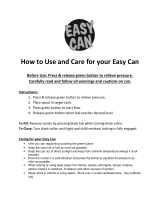
14
Operation
Follow Safety Rules for Operation
After you have checked and fueled the equipment
and positioned it in a suitable worksite, it is time to
start your pressure washer. The following are the
procedures necessary for safe, successful operation
of your pressure washer.
WARNING
Failure to follow safety rules may result in serious injury
or death to the operator or bystanders.
Instruct operators. Owner must instruct all operators in
safe set-up and operation. Do not allow anyone to
operate the pressure washer who has not read the
Owner’s Manual and been instructed on safe use
practices.
Safety equipment/controls. Always operate with all
safety covers, guards, and barriers in place and in good
working order, and all controls properly adjusted for safe
operation.
Moving parts. Keep hands, feet, hair and apparel away
from moving parts. Air vents may cover moving parts
and should be avoided as well. Never remove any
guards while the unit is operating.
Ear Protection. Hearing can be damaged from
prolonged, close-range exposure to the type of noise
produced by this pressure washer. The use of ear plugs
or other hearing protection device is recommended for
persons working within 15-20 feet of the running
pressure washer for an extended period of time.
Eye Protection. Wear ANSI/OSHA required “Z87.1”
safety glasses when operating or servicing the pressure
washer. Pressurized spray from this unit can cause
severe injury to the eyes. Small objects can become
airborne as the spray contacts them.
NOTE!
Before starting the pressure washer, review the
following general safety rules for operation:
Conditions for Use
Know how to stop. Be thoroughly familiar with proper
use of the equipment and all controls and connections.
Know how to stop the pressure washer and
depressurize system quickly if needed.
Instruct all operators. The pressure washer's owner
must instruct all operators and potential renters in safe
set-up and operation. Do not allow anyone to operate
the pressure washer who has not read the Owner's
Manual and been instructed on its safe use.
Adult control only. Only trained adults should set up
and operate the pressure washer. Do not let children
operate. Pressure washers can generate forces greater
than children can control and require judgment beyond
what can be expected of children.
Under the influence. Never operate, or let anyone else
operate, the pressure washer while fatigued or under
the influence of alcohol, drugs, or medication.
Safety equipment / controls in place. Do not operate
the pressure washer unless all safety covers, guards,
and barriers are in place and in good working order, and
all controls are properly adjusted for safe operation.
Damaged. Do not operate the pressure washer with
damaged, missing, or broken parts. Never attempt to
repair a high pressure hose or component. Always
replace it with a part that is rated at or above the
pressure rating of the machine.
Modifications. Do not modify the pressure washer in
any way or deactivate any safety device. Do not change
or add to fuel tank, fuel lines, or exhaust system.
Modifications can result in hazards related to carbon
monoxide poisoning, fuel leaks, fire, explosion or other
serious safety hazards, and will also void the warranty.
During Use
Stay alert. Watch what you are doing at all times.
Clear work area. Clear the work area of all bystanders.
Keep children and pets away.
Keep spray away from electrical wiring. Spray
contact with electrical wiring will likely result in severe
electrical shock or electrocution.
Hot exhaust/parts. Stay clear of engine exhaust.
Never touch hot engine muffler, or other hot surfaces.
All are very hot and will burn you.
Do not direct spray at this machine. Do not attempt to
clean this machine with its own spray. Engine damage
will result. Cleaning should be done with a damp sponge
with the engine OFF.
Let engine cool at least two minutes before
refueling.
Avoid inhalation of exhaust. This product emits CO
and chemicals known to the State of California to cause
cancer, birth defects or other reproductive harm.





















